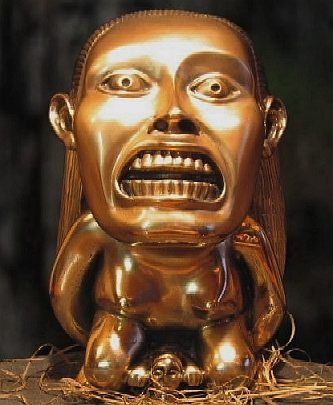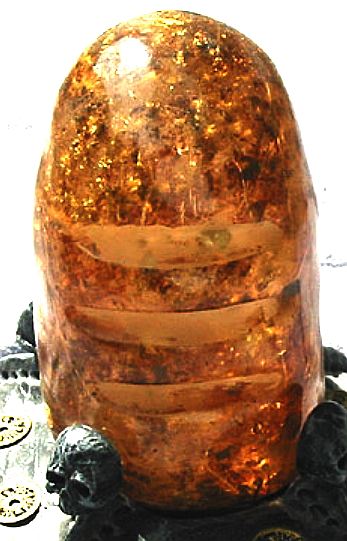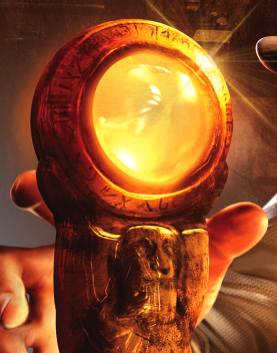|
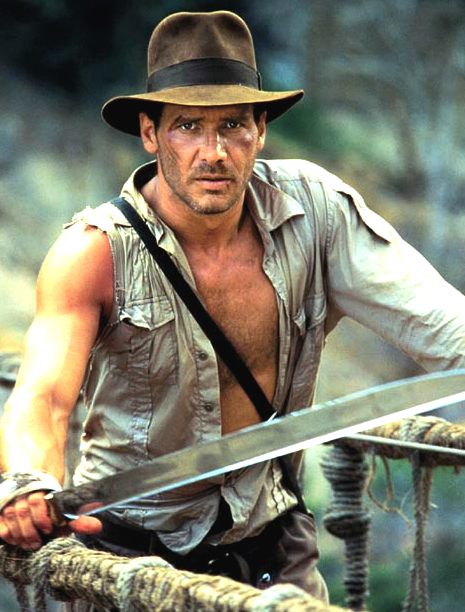
Dr. Henry Walton "Indiana" Jones, Jr., usually nicknamed as "Indy" for short, is the title character and protagonist of the Indiana Jones franchise. George Lucas created the character in homage to the action heroes of 1930s film serials. The character first appeared in the 1981 film Raiders of the Lost Ark, to be followed by Indiana Jones and the Temple of Doom in 1984, Indiana Jones and the Last Crusade in 1989, The Young Indiana Jones Chronicles from 1992 to 1996, and Indiana Jones and the Kingdom of the Crystal Skull in 2008. Alongside the more widely known films and television programs, the character is also featured in novels, comics, video games, and other media. Jones is also featured in the Disney theme park attraction Indiana Jones Adventure, which exists in similar forms at Disneyland and Tokyo DisneySea.
Jones is most famously played by Harrison Ford and has also been portrayed by River Phoenix (as the young Jones in The Last Crusade) and in the television series The Young Indiana Jones Chronicles by Corey Carrier, Sean Patrick Flanery, and George Hall. Doug Lee has supplied Jones's voice to two LucasArts video games, Indiana Jones and the Fate of Atlantis and Indiana Jones and the Infernal Machine, while David Esch supplied his voice to Indiana Jones and the Emperor's Tomb and John Armstrong in Indiana Jones and the Staff of Kings.
Particularly notable facets of the character include his iconic look (bullwhip, fedora, and leather jacket), sense of humor, supposedly deep knowledge of many ancient civilizations and languages, and fear of snakes.
Since his first appearance in Raiders of the Lost Ark, Indiana Jones has become a worldwide star and remains one of cinema's most revered film characters. In 2003, the American Film Institute ranked him as the second greatest film hero of all time. He was also named the 6th Greatest Movie Character by Empire magazine. Entertainment Weekly ranked Indy 2nd on their list of The All-Time Coolest Heroes in Pop Culture. Premiere magazine also placed Indy at number 7 on their list of The 100 Greatest Movie Characters of All Time. On their list of the 100 Greatest Fictional Characters, Fandomania.com ranked Indy at number 10.
A native of Princeton, New Jersey, Indiana Jones was first introduced in the 1981 film Raiders of the Lost Ark, set in 1936. The character is an adventurer reminiscent of the 1930s film serial treasure hunters and pulp action heroes, whose research is funded by Marshall College (named after producer Frank Marshall), a fictional college in Connecticut, where he is a professor of archaeology. In this first adventure, he is pitted against the Nazis, traveling the world to prevent them from recovering the Ark of the Covenant (see also Biblical archaeology). He is aided by Marion Ravenwood and Sallah. The
Nazis are led by Jones's archrival, a Nazi-sympathizing French archaeologist named René
Belloq, and Arnold Toht, a sinister Gestapo agent.
In the 1984 prequel, Indiana Jones and the Temple of Doom, set in 1935, Jones travels to India and attempts to recover enslaved children and the three Sankara stones from the bloodthirsty Thuggee cult. He is aided by Short Round, a young boy, and is accompanied by singer Willie Scott (Kate Capshaw).
The third film, 1989's Indiana Jones and the Last Crusade, set in 1938, returned to the formula of the original, reintroducing characters such as Sallah and Marcus Brody, a scene from Professor Jones's classroom (he now teaches at Barnett College), the globe trotting element of multiple locations, and the return of the infamous Nazi mystics, this time trying to find the Holy Grail. The film's introduction, set in 1912, provided some back story to the character, specifically the origin of his fear of
snakes, his use of a bullwhip, the scar on his chin, and his hat; the film's epilogue also reveals that "Indiana" is not Jones's first name, but a nickname he took from the family dog. The film was a buddy movie of sorts, teaming Jones with his father, often to comical effect. Although Lucas intended at the time to do five films, this ended up being the last for over eighteen years, as Lucas could not think of a good plot element to drive the next installment.
The 2008 film, Indiana Jones and the Kingdom of the Crystal Skull, became the latest film in the series. Set in 1957, 19 years after the third film, it pits an older, wiser Indiana Jones against Soviet agents bent on harnessing the power of a crystal skull associated with extraterrestrials discovered in South America by his former colleague Harold Oxley (John Hurt). Jones is aided in his adventure by his former lover, Marion Ravenwood (Karen Allen), and her son—a young greaser named Henry "Mutt" Williams (Shia LaBeouf), later revealed to be Jones's biological child, Henry Jones III. There were rumors that LaBeouf will take over the Indy franchise. This film also reveals that Jones was recruited by the Office of Strategic Services (a predecessor department to the Central Intelligence Agency) during
World War II, attaining the rank of Colonel in the United States Army and running covert operations with MI6 agent George McHale on the Soviet Union.
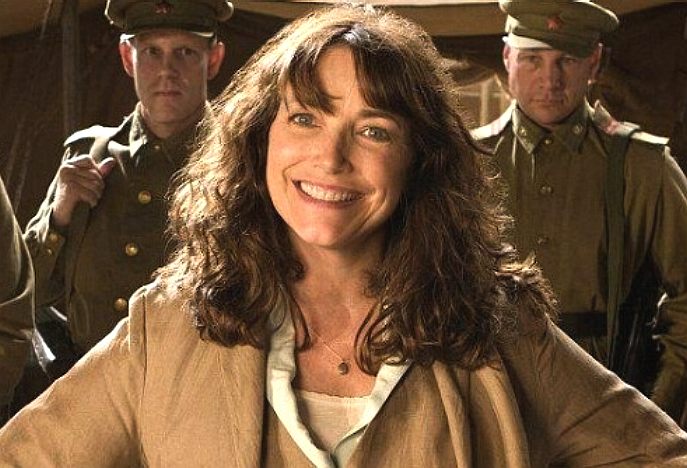
CHARACTER DESCRIPTION
In his role as a college professor of archaeology, Henry Jones Jr. is scholarly and learned in a tweed suit, lecturing on ancient civilizations. In Indiana Jones and the Kingdom of the Crystal Skull, it is revealed that Jones is influenced by the Marxist Archaeologist, Vere Gordon Childe, whose qualified acceptance of cultural diffusionism theory he propounds. Ironically, though Childe loathes fieldwork, Indy goes on to say, "If you want to be a good archaeologist, you gotta get out of the library." This is in tongue-in-cheek contrast to the previous film's comment, "Seventy percent of all archaeology is done in the library."
However, at the opportunity to recover important artifacts, Dr. Jones transforms into "Indiana," a "non-superhero superhero" image he has concocted for himself. Producer Frank Marshall said, "Indy [is] a fallible character. He makes mistakes and gets hurt. [...] That's the other thing people like: He's a real character, not a character with superpowers." Spielberg said there "was the willingness to allow our leading man to get hurt and to express his pain and to get his mad out and to take pratfalls and sometimes be the butt of his own jokes. I mean, Indiana Jones is not a perfect hero, and his imperfections, I think, make the audience feel that, with a little more exercise and a little more courage, they could be just like him." According to Spielberg biographer Douglas Brode, Indiana created his heroic figure so as to escape the dullness of teaching at a school. Both of Indiana's personas reject one another in philosophy, creating a duality. Harrison Ford said the fun of playing the character was because Indiana is both a romantic and a cynic, while scholars have analyzed Indiana as having traits of a lone wolf; a man on a quest; a noble treasure hunter; a hardboiled detective; a human superhero; and an American patriot.
Like many characters in his films, Jones has some autobiographical elements of Spielberg. Indiana lacks a proper father figure because of his strained relationship with his father, Henry Senior. His own contained anger is misdirected towards Professor Abner Ravenwood, his mentor at the University of Chicago, leading to a strained relationship with Marion Ravenwood. The teenage Indiana bases his own look on a figure from the prologue of Indiana Jones and the Last Crusade, after being given his hat. Marcus Brody acts as Indiana's positive role model at the college. Indiana's own insecurities are made worse by the absence of his mother. In Indiana Jones and the Temple of Doom, he becomes the father figure to Willie Scott and Short Round, to survive; he is rescued from Kali's evil by Short Round's dedication. Indiana also saves many enslaved children.
Because of Indiana's strained relationship with his father, who was absent much of Indiana's youth searching for the Holy Grail, the character does not pursue the more spiritual aspects of the cultures he studies. Indiana uses his knowledge of Shiva to defeat Mola Ram. In Raiders, however, he is wise enough to close his eyes in the presence of God in the Ark of the Covenant. By contrast, his rival Rene Belloq is killed for having the audacity to try to communicate directly with God.
In the prologue of Indiana Jones and the Last Crusade, Jones is seen as a teenager, establishing his look when given a hat. Indiana's intentions are revealed as prosocial, as he believes artifacts "belong in a museum." In the film's climax, Indiana undergoes "literal" tests of faith to retrieve the Grail and save his father's life. He also remembers Jesus as a historical figure – a humble carpenter – rather than an exalted figure when he recognizes the simple nature and tarnished appearance of the real Grail amongst a large assortment of much more ornately decorated ones. Henry Senior rescues his son from falling to his death when reaching for the fallen Grail, telling him to "let it go," overcoming his mercenary nature. The Young Indiana Jones Chronicles explains how Indiana becomes solitary and less idealistic following his service in World War I. In Indiana Jones and the Kingdom of the Crystal Skull, Jones is older and wiser, whereas his sidekicks Mutt and Mac are youthfully arrogant and greedy, respectively.
Indiana Jones is modeled after the strong-jawed heroes of the matinée serials and pulp magazines that George Lucas and Steven Spielberg enjoyed in their childhoods (such as the Republic Pictures serials, and the Doc Savage series). Sir H. Rider Haggard's safari guide/big game hunter Allan Quatermain of King Solomon's Mines, who dates back to 1885, is a notable template for Jones. The two friends first discussed the project in Hawaii around the time of the release of the first Star Wars film. Spielberg told Lucas how he wanted his next project to be something fun, like a James Bond film. According to sources, Lucas responded to the effect that he had something "even better," or that he "got that beat."
Two of the possible bases for Indiana Jones are Professor Challenger, created by Sir Arthur Conan Doyle in 1912 for his novel, The Lost World. Challenger was based on Doyle's physiology professor, Sir William Rutherford, an adventuring academic, albeit a zoologist/anthropologist.
The character was originally named Indiana Smith, after an Alaskan Malamute Lucas owned in the 1970s (Indiana); the name was perhaps in a nod to the 1966 Western film Nevada Smith. Spielberg disliked the name Smith, and Lucas casually suggested Jones as an alternative.
Lucas has said on various occasions that Sean Connery's portrayal of British secret agent
James Bond was one of the primary inspirations for Jones, a reason Connery was chosen for the role of Indiana's father in Indiana Jones and the Last Crusade.
Costume designer Deborah Nadoolman Landis noted that the inspiration for the series as well as Indiana Jones' outfit was Charlton Heston's Harry Steele in Secret of the Incas (1954) and called Raiders of the Lost Ark "almost a shot for shot" remake of the Heston film, citing that Indiana Jones was "a kinder, gentler Harry Steele": "We did watch this film together as a crew several times, and I always thought it strange that the filmmakers did not credit it later as the inspiration for the series."
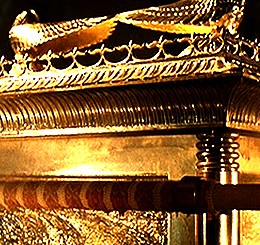
HISTORICAL MODELS
Many people are said to be the real-life inspiration of the Indiana Jones character—although none of the following have been confirmed as inspirations by
Lucas or Spielberg. There are some suggestions, listed here in alphabetical order by last name:
Beloit College professor and paleontologist Roy Chapman Andrews.
Italian archaeologist and circus strongman Giovanni Battista Belzoni (1778–1823).
Yale University professor, historian, and explorer Hiram Bingham III, who rediscovered and excavated the lost city of Machu Picchu, and chronicled his find in the bestselling book The Lost City of the Incas in 1948.
University of Chicago archaeologist Robert Braidwood.
University of Chicago archaeologist James Henry Breasted.
British archaeologist Percy Fawcett, who spent much of his life exploring the jungles of northern Brazil, and who was last seen in 1925 returning to the Amazon Basin to look for the Lost City Of Z. A fictionalized version of Fawcett appears to Jones in the book Indiana Jones And The Seven Veils.
American archaeologist Walter Fairservis.
Harvard University paleontologist Farish Jenkins.
British archaeologist and soldier T. E. Lawrence.
Northwestern University anthropologist, professor and adventurer William Montgomery McGovern.
English adventurer Frederick Albert Mitchell-Hedges.
German archaeologist Otto Rahn.
Harvard University archaeologist and art historian Langdon Warner.
ARCHAEOLOGY & ETHICS
In general, when asking a member of the public to name an archaeologist, or even something about archaeology, Indiana Jones comes up. Students of archaeology and professionals alike often name Indiana Jones as one of their inspirations, or maybe what interested them in archaeology to begin with, despite some obvious issues with how Dr. Jones practices archaeology. No stranger to criticism when it comes to the practice of archaeology (treasure-hunter, looter, etc.), Indiana Jones, as representative of archaeology and anthropology as a whole, has some deeper, core ethical issues as well. Cultural relativism, succinctly defined as regarding all cultures as equally valid, lies at the core of what archaeologists and anthropologists do. While far from perfect, it is at least something to strive for – the ability to see outside one’s own cultural biases, to be as un-ethnocentric as possible. Indiana Jones doesn't seem to be striving very hard. Relations with indigenous peoples are in important ethical debates in archaeology today, along with issues of ownership, who has the right to interpret the past, and of course, looting.
Indiana Jones begins the first film immediately addressing ethical issues – as in, showing us the wrong way to go about archaeology. He has a side-kick, or perhaps a hired guide, an obvious representative of the indigenous people there. The guide fumbles along, not once asked for advice by Indiana, eventually even attempting to take the artifact for himself. The audience of course sees this as wrong – since Indiana found the artifact, it must be his. In reality, the guide may have held a more substantial claim. Ownership of archaeological sites or materials is notoriously slippery, but the Indiana Jones leads audiences to the incorrect assumption of finders-keepers, and that preservation and understandings lies solely with academics from the West.
The ethical dilemmas of Indiana Jones are still current today, but they also reflect the roots of the archaeological discipline.
Archaeology dates back much further, where affluent and enthusiastic collectors kept artifacts to show off to friends, but the discipline itself is rooted in colonialism. "The earliest development of archaeology then is the transformation from a hobby of those economically advantaged enough to pursue it, to a serious and highly regarded academic discipline." Indiana Jones represents the beginnings of that discipline, still very much in its infant stages, and unfortunately leading modern audiences to adopt the ideals taught in the three, now four, films.
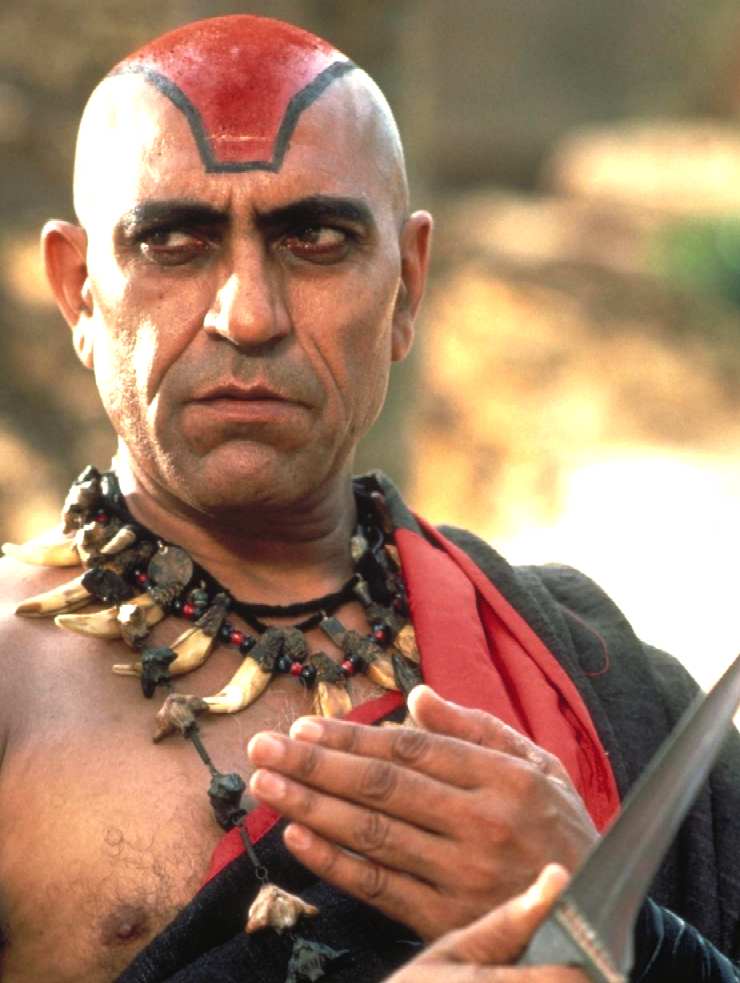
COSTUME
Upon requests by Spielberg and Lucas, the costume designer gave the character a distinctive silhouette through the styling of the hat; after examining many hats, the designers chose a tall-crowned, wide-brimmed fedora. As a documentary of Raiders pointed out, the hat served a practical purpose. Following the lead of the old "B"-movies that inspired the Indiana Jones series, the fedora hid the actor's face sufficiently to allow doubles to perform the more dangerous stunts seamlessly. Examples in Raiders include the wider-angle shot of Indy and Marion crashing a statue through a wall, and Indy sliding under a fast-moving vehicle from front to back. Thus it was necessary for the hat to stay in place much of the time.
The hat became so iconic that the filmmakers could only come up with very good reasons or jokes to remove it. If it ever fell off during a take, filming would have to stop to put it back on. In jest, Ford put a stapler against his head to stop his hat from falling off when a documentary crew visited during shooting of Indiana Jones and the Last Crusade. This created the urban legend that Ford stapled the hat to his head. Although other hats were also used throughout the films, the general style and profile remained the same. Elements of the outfit include:
The fedora was supplied by Herbert Johnson Hatters in England for the first three films. It was referred to as "The Australian Model" by costume designer Deborah Landis and was fitted with a Petersham bow. The fedora for Crystal Skull was made by Steve Delk and Marc Kitter of the Adventurebilt Hat Company of Columbus, Mississippi.
The leather jacket, a hybrid of the "Type 440" and the A-2 jacket, was made by Leather Concessionaires (now known as Wested Leather Co.) for Raiders of the Lost Ark and Indiana Jones and the Last Crusade. For Indiana Jones and the Temple of Doom, jackets were made in-house at Bermans & Nathans in London based on a stunt jacket they provided for Raiders of the Lost Ark. Tony Nowak made the jacket for Indiana Jones and the Kingdom of the Crystal Skull.
The Indiana Jones shirt is based on a typical safari-style shirt. Its distinctive feature is two vertical strips running from the shoulders to the bottom of the shirt tails and continued over both breast pockets. A common debate regards the original shirt color. Surviving samples of the original shirts seem to be darker in reality than they appear on screen. Most fans look for an off-white "stone" color for their replicas. The original shirts, however, may have been more of a "tan" or "natural" color. The shirt varied little from film to film, the only notable difference being the darker buttons in Temple of Doom and Last Crusade. Originally designed by Andreas Dometakis for the films, this shirt was once one of the hardest pieces of gear to find.
The pants worn by Indiana Jones in all three films were based on original World War II Army and Army Air Corps officer trousers. Although not original Pinks they are based on the same basic design and do carry a slight pinkish hue. The pants made for Raiders are said to be more of a greyish-brown where the pants made for Temple of Doom and Last Crusade were supposedly a purer reddish-brown. The pants were made of a khaki wool-twill, pleated with seven belt loops, two scalloped button flap rear pockets, a button fly and a four-inch military style hem. They were all most likely subcontracted by the costume department and made by famed London based cinema costumers, Angels and Bermans, to be tailored perfectly for Harrison Ford for the production.
The bag was a modified Mark VII British gas mask bag, usually worn under the jacket with the exception of Crystal Skull where the bag was worn over the jacket.
The whip was a 8 to 10 foot (2.4 to 3.0 m) bullwhip crafted by David Morgan for the first three films. The whips for Crystal Skull were crafted by a variety of people, including Terry Jacka, Joe Strain and Morgan (different lengths and styles were likely used in specific stunts).
The pistol was usually a World War I-era revolver, including the Webley Government (Last Crusade and Crystal Skull), or a .45 ACP Smith & Wesson Hand Ejector 2nd model revolver (Raiders). He has also used an M1917 revolver (Temple of Doom), a Nagant M1895 (Young Indiana Jones), and a 9 mm Browning Hi-Power (Raiders). The weapon is carried in a military pattern flap holster.
The shoes were made by Alden. A stock style (model 405) that had been a favorite of Ford's before the films, they are still sold today (though in a redder (brick) shade of brown than seen in the films) and are popularly known as "Indy Boots."
The fedora and leather jacket from Indiana Jones and the Last Crusade are on display at the Smithsonian Institution's American History Museum in Washington, D.C. The collection of props and clothing from the films has become a thriving hobby for some aficionados of the franchise. Jones' whip was the third most popular film weapon, as shown by a 2008 poll held by 20th Century Fox, which surveyed approximately two thousand film fans.
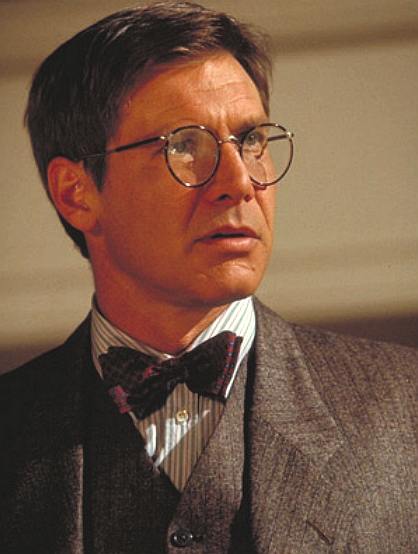
CASTING
Originally, Spielberg suggested Harrison Ford; Lucas resisted the idea, since he had already cast the actor in American Graffiti, Star Wars, and The Empire Strikes Back, and did not want Ford to become known as his "Bobby De Niro" (in reference to the fact that fellow director Martin Scorsese regularly cast Robert De Niro in his films). During an intensive casting process, Lucas and Spielberg auditioned many actors, and finally cast then little-known actor Tom Selleck as Indiana Jones. Shortly afterward pre-production began in earnest on Raiders of the Lost Ark. However, CBS refused to release Selleck from his contractual commitment to Magnum, P.I. (which was gradually gaining momentum in the ratings), forcing him to turn down the role. One of CBS's concerns was that shooting for Magnum P.I. conflicted with shooting for Raiders, both of which were to begin about the same time. However, Selleck was to say later in an interview that shooting for Magnum P.I. was delayed and did not actually begin until shooting for Raiders had concluded.
After Spielberg suggested Ford again, Lucas gave in, and Ford was cast in the role less than three weeks before filming began.
INFLUENCE
Though some archaeologists criticize Indy's methods as befitting a "looter" rather more than a careful worker of precious sites, many have adopted the popular figure as something of a standard-bearer for their profession. The industry magazine Archaeology, believing that Jones, as one editor said, was "a horrible archaeologist but a great diplomat for archaeology," named eight past and current archaeologists who they felt "embodied [Jones'] spirit" as recipients of the "Indy Spirit Awards" in 2008. That same year Ford himself was elected to the Board of Directors of the Archaeological Institute of America. Commenting that "understanding the past can only help us in dealing with the present and the future," Ford was praised by the association's president for his character's "significant role in stimulating the public's interest in archaeological exploration."
While himself a homage to various prior adventurers, aspects of Indiana Jones also directly influenced some subsequent characterizations:
Lara Croft, the female archaeologist of the Tomb Raider series, was originally designed as a man, but was changed to a woman, partly because the developers felt that the original design was too similar to Indiana Jones. Paramount Pictures, which distributed the Indiana Jones film series, would later make two films based on the Tomb Raider games.
Prince of Persia producer Ben Mattes explained that their "inspiration was anything Harrison Ford has ever done: Indiana Jones, Han Solo."
The video game series Uncharted is also very heavily influenced and inspired by Indiana Jones. The main character, Nathan Drake, also shares many similarities with Jones himself, both visually and personality-wise. The design team felt the sources shared themes of mystery and "what-if scenarios" that romanticized adventure and aimed to include those in Uncharted.
Mutiny
of the Bounty
A
- Z FILMS INDEX
A
- Z ACTORS INDEX
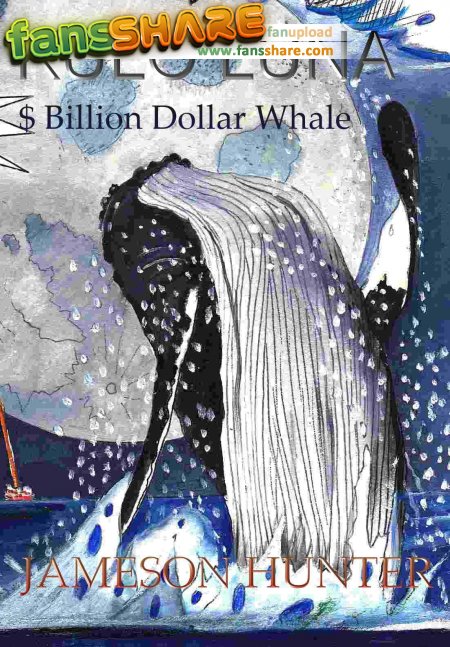
A
heartwarming action adventure with ocean
awareness overtones: Pirate
whalers
V Conservationists,
introducing
John Storm and his solar powered robot ship, the Elizabeth
Swan,
as
they fight to save a wounded whale from the sushi bars.
|
